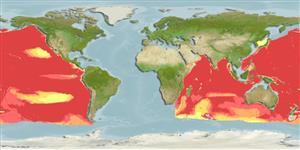Environment: milieu / climate zone / depth range / distribution range
Ecología
marino batipelágico; rango de profundidad 500 - 800 m (Ref. 4058). Deep-water
Indo-Pacific: in tropical and subtropical waters. All previous records of Evermannella indica from the Atlantic are now known to be Evermannella melanoderma, a distinct species (Ref. 41336). South China Sea (Ref.74511).
Tamaño / Peso / Age
Maturity: Lm ? range ? - ? cm
Max length : 11.9 cm SL macho / no sexado; (Ref. 4058)
Espinas dorsales (total): 0; Radios blandos dorsales (total): 12-13; Espinas anales 0; Radios blandos anales: 27 - 31; Vértebra: 48 - 52. Color in alcohol light brown with numerous melanophores on head and body (Ref. 4058). Pigmentation varies from pale-colored pigmentation to a brownish-black pigmentation (Ref. 4058). Branchiostegal rays: 8 (Ref. 36017).
Mesopelagic at 0-800 m (Ref. 58302). Oviparous, with planktonic larvae (Ref. 36017).
Life cycle and mating behavior
Madurez | Reproducción | Puesta | Huevos | Fecundidad | Larva
Swinney, G.N., 1994. Comments on the Atlantic species of the genus Evermannella (Scopelomorpha, Aulopiformes, Evermannellidae) with a re-evaluation of the status of Evermanella melanoderma. J. Fish Biol. 44(5):809-819. (Ref. 41336)
IUCN Red List Status (Ref. 130435)
Threat to humans
Harmless
Human uses
Pesquerías: sin interés
Más información
ReferenciasAcuiculturaPerfil de acuiculturaRazasGenéticaElectrophoresesheritabilidadEnfermedadesProcesamientoNutrientsMass conversion
Herramientas
Special reports
Download XML
Fuentes de Internet
Estimates based on models
Preferred temperature (Ref.
123201): 2.1 - 10, mean 7.6 °C (based on 221 cells).
Phylogenetic diversity index (Ref.
82804): PD
50 = 0.5352 [Uniqueness, from 0.5 = low to 2.0 = high].
Bayesian length-weight: a=0.00417 (0.00157 - 0.01110), b=3.12 (2.89 - 3.35), in cm total length, based on LWR estimates for this (Sub)family-body shape (Ref.
93245).
Nivel trófico (Ref.
69278): 4.1 ±0.7 se; based on size and trophs of closest relatives
Fishing Vulnerability (Ref.
59153): Low vulnerability (10 of 100).
